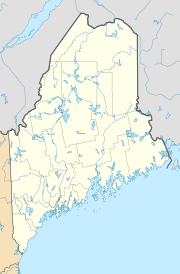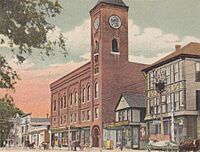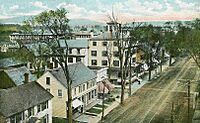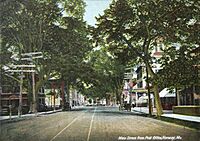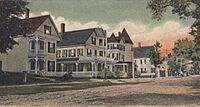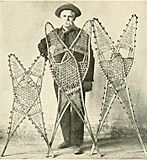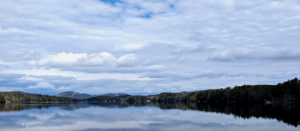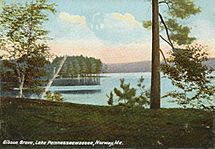Norway, Maine facts for kids
Quick facts for kids
Norway, Maine
|
|
|---|---|
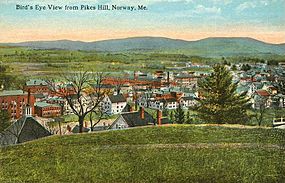
Bird's-eye view from Pikes Hill c. 1912
|
|
| Country | United States |
| State | Maine |
| County | Oxford |
| Area | |
| • Total | 47.33 sq mi (122.58 km2) |
| • Land | 45.04 sq mi (116.65 km2) |
| • Water | 2.29 sq mi (5.93 km2) |
| Elevation | 387 ft (118 m) |
| Population
(2020)
|
|
| • Total | 5,077 |
| • Density | 113/sq mi (43.5/km2) |
| Demonym(s) | Norwegian |
| Time zone | UTC−05:00 (Eastern (EST)) |
| • Summer (DST) | UTC−04:00 (EDT) |
| ZIP Code |
04268
|
| Area code(s) | 207 |
Norway is a small town in Oxford County, Maine, in the United States. It's part of the wider Lewiston-Auburn metropolitan area. In 2020, about 5,077 people lived here. Norway is famous for Pennesseewassee Lake, a beautiful freshwater lake that's great for recreation.
Contents
History of Norway
For thousands of years, native people lived around Pennesseewassee Lake. The area had rich soil and lots of animals. European settlers only started building the town of Norway after the American Revolution.
Founding the Town
In 1786, a group of settlers, including Joseph Stevens and George Leslie, began clearing land. They built homes and worked to attract new people to their small community. Many of these early settlers had fought in the Revolutionary War. For example, Phineas Whitney was a veteran of the Battle of Bunker Hill.
By 1789, the settlers had built a sawmill and a gristmill (for grinding grain). The first road was finished in 1796. On March 9, 1797, the town of Norway officially became a town. Before this, it was called Rustfield, named after Henry Rust, a landowner from Salem. The community once asked to be called Norage, which means "falls" in the native language. However, the name Norway was chosen to honor people from Norway, a country in Scandinavia.
Growth and Industry
Norway had fertile soil for farming and good access to waterways. The Pennesseewassee waterways flow into the Little Androscoggin River. This meant the town had plenty of water power to run factories.
Early industries included:
Waterfalls also powered two grain mills. Other businesses grew, like a tannery (for making leather), a harness maker, and a trunk manufacturer. A shoe factory opened in 1872.
Norway was a busy stop on the stage route from Paris (the county seat) to Fryeburg. By 1878, there were 32 stores in town. For a while, Norway was one of the fastest-growing towns in Maine.
The Great Norway Fire and Rebuilding
On December 30, 1879, the Norway Branch Railroad opened. This short train line connected Norway village to the main railroad at South Paris.
However, on May 9, 1894, a fire started at the C. B. Cummings & Sons mill on Main Street. Strong winds quickly spread the fire. This event, known as The Great Norway Fire, destroyed a large part of the business district. It burned down the opera house, the Congregational Church, the tannery, and 80 other buildings, including many homes. Luckily, rebuilding started that same year. Many of the wooden buildings on Main Street were rebuilt with brick, making them stronger.
Snowshoe Capital of the World
Norway became known as the "Snowshoe Capital of the World." This was because of its important snowshoe manufacturers.
- A. M. Dunham started making snowshoes in 1878. His snowshoes were used all over North America. The famous explorer Robert Peary praised them, calling them "the best snow-shoes [he] ever saw."
- Walter Tubbs founded the Tubbs Snowshoe Company in 1906. Tubbs made high-quality ash snowshoes, skis, sleds, and furniture. They even supplied Byrd's polar expeditions. Tubbs moved to Vermont in the early 1930s.
- SnoCraft Inc. took over the old Tubbs Factory. This company, run by Kenneth (Kac) Aldrich, made 70% of the snowshoes ordered by the U.S. government during World War II.
Another important company was C. B. Cummings & Son Company, founded in 1850. They made wooden parts like dowels. However, in 2001, the company closed because it couldn't compete with factories in China. Similarly, when K2 Sports bought Tubbs Snowshoe Company in 2014, production moved to China.
Today, the New Balance Shoe Company has a manufacturing facility in Norway. It was built in 1997 and still makes shoes there.
Image gallery
Life in Norway Today
Norway is part of School Administrative District (SAD) 17. Younger children attend Rowe Elementary School from pre-kindergarten to grade 6. Older students go to Oxford Hills middle school and high school.
The town has its own water system and a facility to treat wastewater. A board of selectmen manages the town. There is also a planning board that helps decide how the town grows.
Geography and Climate
Norway covers about 47.33 square miles (122.58 square kilometers). Most of this is land (45.04 sq mi or 116.65 sq km), and a smaller part is water (2.29 sq mi or 5.93 sq km). The Pennesseewassee Stream and the Little Androscoggin River flow through the town.
Several state routes, including Routes 26, 117, and 118, cross Norway. The town shares borders with several other towns:
- North: Greenwood and West Paris
- East: Paris
- Southeast: Oxford
- South: Otisfield
- Southwest: Harrison
- West: Waterford
- Northwest: Albany
Climate in Norway
Norway has a humid continental climate. This means it has big differences in temperature throughout the year. Summers are warm to hot and often humid. Winters are cold, sometimes very cold.
Population and People
| Historical population | |||
|---|---|---|---|
| Census | Pop. | %± | |
| 1800 | 609 | — | |
| 1810 | 1,010 | 65.8% | |
| 1820 | 1,294 | 28.1% | |
| 1830 | 1,713 | 32.4% | |
| 1840 | 1,786 | 4.3% | |
| 1850 | 1,963 | 9.9% | |
| 1860 | 1,982 | 1.0% | |
| 1870 | 1,954 | −1.4% | |
| 1880 | 2,519 | 28.9% | |
| 1890 | 2,665 | 5.8% | |
| 1900 | 2,902 | 8.9% | |
| 1910 | 3,002 | 3.4% | |
| 1920 | 2,969 | −1.1% | |
| 1930 | 3,145 | 5.9% | |
| 1940 | 3,649 | 16.0% | |
| 1950 | 3,811 | 4.4% | |
| 1960 | 3,733 | −2.0% | |
| 1970 | 3,595 | −3.7% | |
| 1980 | 4,042 | 12.4% | |
| 1990 | 4,754 | 17.6% | |
| 2000 | 4,611 | −3.0% | |
| 2010 | 5,014 | 8.7% | |
| 2020 | 5,077 | 1.3% | |
| U.S. Decennial Census | |||
In 2010, there were 5,014 people living in Norway. There were 2,163 households and 1,357 families. The population density was about 111 people per square mile (43 people per square kilometer). Most residents (96.1%) were White. About 21.4% of the people were under 18 years old, and 20.1% were 65 or older. The average age in Norway was 44.4 years.
Places to Visit
- Norway Historical Society & Museum
- Historical Walking Tour of Norway, Maine
Notable People from Norway
Many interesting people have come from Norway, Maine, including:
- George Lafayette Beal: A general during the Civil War and later a state treasurer.
- Mellie Dunham: A fiddler and snowshoe maker.
- Talbot Mundy: A well-known author.
- Donald B. Partridge: A U.S. Representative.
- Don Carlos Seitz: An author and journalist.
Images for kids
See also
 In Spanish: Norway (Maine) para niños
In Spanish: Norway (Maine) para niños


